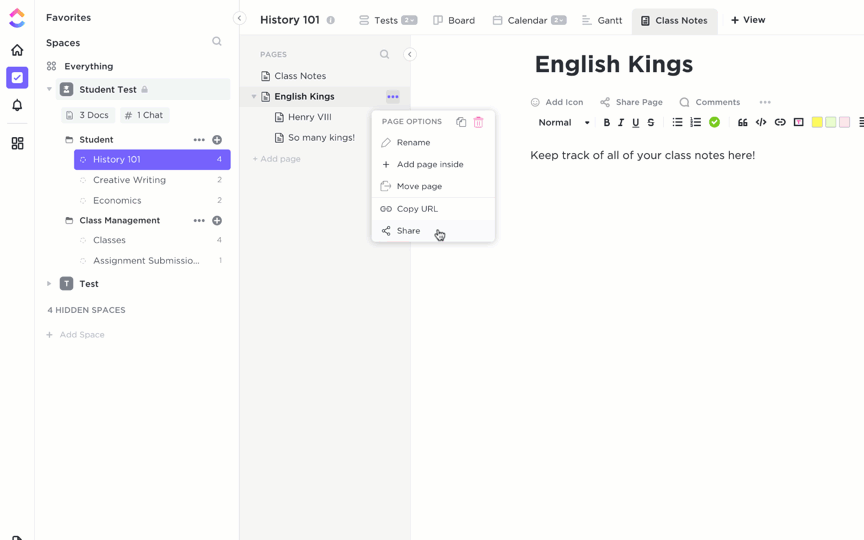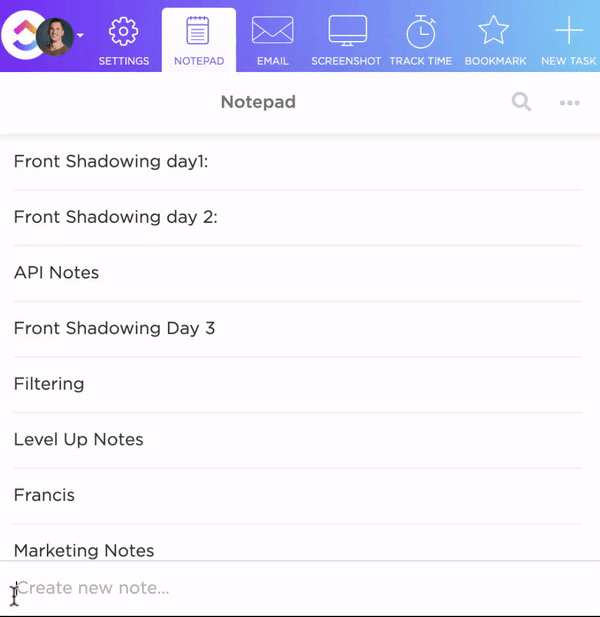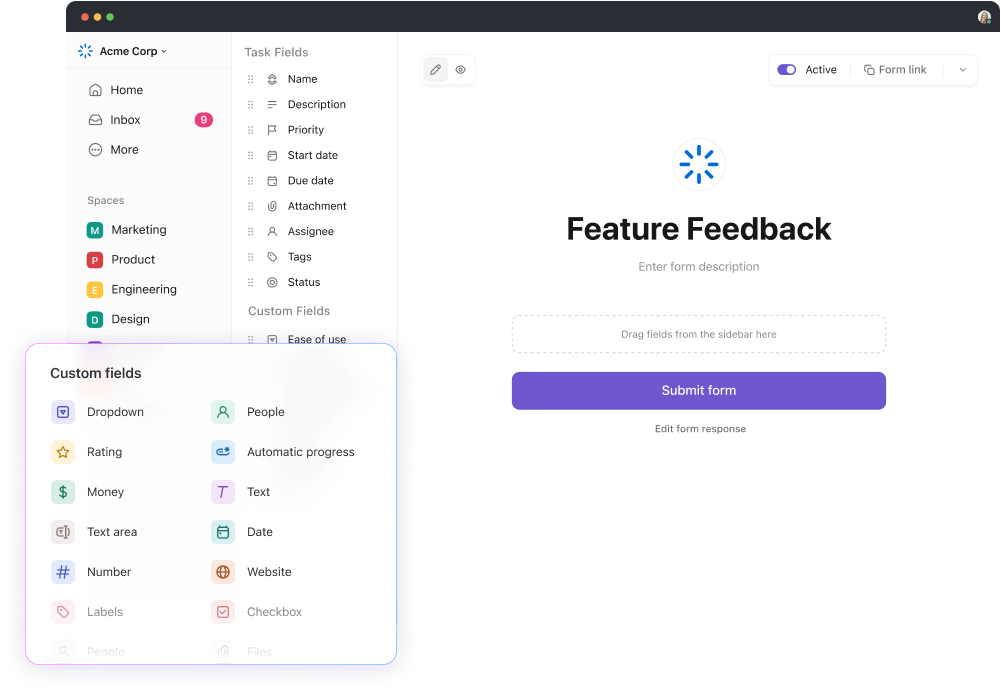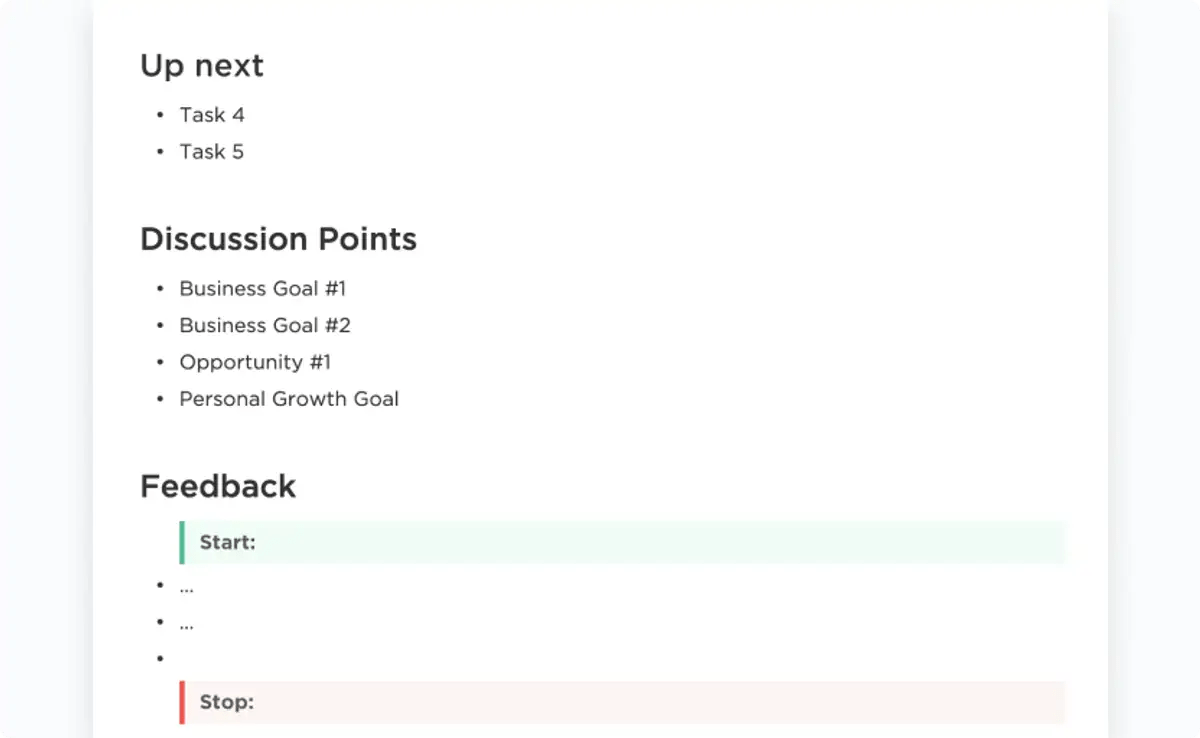هل تعلم أنه عندما يقدم المديرون ملاحظات يومية للموظفين، فإن الموظفين 3.6 مرات أكثر عرضة للشعور بالحافز للقيام بعمل متميز؟
تعد التغذية الراجعة أداة قوية تلعب دورًا هامًا في تقدم ونجاح أي مؤسسة. فهي تساعد على خلق مكان عمل يُسمع فيه كل صوت، وتُقدّر فيه كل فكرة، وتتاح فيه الفرصة لكل فرد للنمو والازدهار.
تتيح لك جلسة التغذية الراجعة التواصل بصراحة وصراحة مع فريقك وتعزز المشاركة. ويمكنك تقديم رؤى حول مجالات التحسين، والإشادة بنقاط قوتهم، ومساعدتهم على وضع خطة تدفعهم إلى النمو الشخصي والمهني.
ومع ذلك، فإن عقد جلسة تقييم ناجحة هو أكثر من مجرد الدعوة لعقد اجتماع. حيث تتطلب كل من المراجعات السنوية للأداء وجلسات إبداء الملاحظات المخصصة بعض التدريب والتحضير. في هذا المقال، سنطلعك في هذا المقال على فوائد وتحديات جلسات التغذية الراجعة وخطوات عقد جلسة ناجحة.
فوائد جلسات التغذية الراجعة للموظفين
يمكن أن يؤدي عقد جلسات التغذية الراجعة المنتظمة إلى رفع مستوى النمو ومشاركة أعضاء الفريق. دعنا نلقي نظرة على بعض فوائد جلسات التغذية الراجعة.
تحفيز الموظفين
لا تقتصر الملاحظات التقييمية المنتظمة على مشاركة مجالات التحسين ونقاط الضعف فحسب، بل تتضمن أيضًا الثناء على نقاط قوة الموظفين وإنجازاتهم والاعتراف بها. وهذا يساعد على تحفيز الموظفين ويجعلهم يشعرون بالتقدير ويحسن من تقديرهم لذاتهم.
تعزز التنمية الشاملة
تتيح جلسات التغذية الراجعة التطوير الشامل للموظفين. فالتغذية الراجعة الصحيحة في الوقت المناسب تساعدهم على تحليل أدائهم ونقاط قوتهم ومجالات نموهم. كما تعزز التغذية الراجعة البناءة أيضًا التطور الشخصي والمهني.
تحل النزاعات
من الفوائد الأخرى للتغذية الراجعة المنتظمة هي قدرتها على حل النزاعات قبل أن تتحول إلى مشاكل كبيرة.
تمكّن جلسات التغذية الراجعة المنتظمة أعضاء فريقك من مشاركة وجهات نظرهم وإجراء محادثات صعبة مع بعضهم البعض، بما في ذلك حل سوء التفاهم البسيط الذي لا يبدو كبيراً في البداية. وهذا يمنعها من التطور إلى نزاعات كاملة.
تعزز المشاركة
يرغب الجميع في سماع ما قاموا به بشكل جيد وكيف يمكنهم التحسن بعد العمل على مشروع ما. والأمر نفسه ينطبق على فريقك. حسب مؤسسة غالوب 80% من الموظفين يقولون إن التغذية الراجعة الهادفة تساعدهم على المشاركة الكاملة
يكون الموظفون المتفاعلون أكثر تفانيًا وحماسًا تجاه عملهم، وبالتالي تحسين معدلات النجاح والاحتفاظ بهم.
التواصل المفتوح
تعمل التعليقات المتكررة على تطوير ثقافة التواصل المفتوح في مكان عملك. إن تشجيعها يخلق بيئة يمكن لأعضاء فريقك التعبير عن مخاوفهم وأفكارهم بحرية.
كما أنه يساعدهم على الانفتاح على النقد وتقدير الملاحظات الإيجابية. وهذا في نهاية المطاف يحسن التعاون و ديناميكيات الفريق .
تحسين الأداء
بدون التغذية الراجعة البناءة، لن يعرف فريقك ما الذي يقومون به بشكل جيد وما الذي يحتاج إلى تحسين. تساعدهم عملية تقديم التغذية الراجعة المنتظمة على تحسين أدائهم ويكونوا أكثر تحفيزًا في العمل.
وبالمثل، فإن التغذية الراجعة أمر بالغ الأهمية لتحديد القيادة فعالية الاستراتيجية. من خلال التواصل مع أعضاء فريقك، يمكنك تحسين مهاراتك واختيار الاستراتيجية الأكثر فعالية.
التحديات في تنفيذ جلسات التغذية الراجعة الفعالة
التردد، والتحيز، وضعف مهارات التواصل، والأهداف غير الواضحة كلها تحديات تواجه تنفيذ جلسات التغذية الراجعة الفعالة. دعونا نناقش كيف.
1. عدم وجود تغذية راجعة محددة
أحد أهم التحديات هو عدم وجود ملاحظات محددة. على سبيل المثال، قول: "يحتاج عرضك التقديمي إلى التحسين"، لا يوضح ما هو الجانب الذي يحتاج إلى تحسين. يمكن أن يترك متلقي الملاحظات في حيرة من أمره.
كيفية التغلب على هذا التحدي:
ركز على سلوكيات أو نتائج محددة لتقديم ملاحظات واضحة وقابلة للتنفيذ. بدلاً من العبارات الغامضة، قدم أمثلة واقتراحات ملموسة.
أفضل مثال على الملاحظات في السيناريو أعلاه سيكون القول: "كان عرضك التقديمي غنيًا بالمعلومات، ولكن هناك مجالات يمكنك تحسينها. بعض شرائحك كانت مليئة بالنصوص، مما جعل من الصعب متابعة النقاط الرئيسية."
هذا يتناول أجزاء العرض التقديمي التي تحتاج إلى تحسين.
2. الخوف من ردود الأفعال السلبية أو المواجهات
من التحديات الأخرى التي تواجه المديرين في كثير من الأحيان الخوف من ردود الفعل السلبية من أعضاء الفريق. قد تقلق من تثبيط عزيمة موظفيك أو الإضرار بالعلاقات. وبالمثل، فإن الخوف من المواجهة يعيق التواصل الصادق والمفتوح.
إن استخدام نهج متوازن أثناء تقديم الملاحظات هو مهارة قيادية يجب تطويرها . يمكن أن يؤدي إعطاء التغذية الراجعة السلبية فقط إلى خفض معنويات الموظفين والتأثير على رغبتهم في العمل. ومن ناحية أخرى، فإن إعطاء التغذية الراجعة الإيجابية فقط يمكن أن يؤدي إلى الشعور بالرضا عن النفس ويعيق النمو.
كيفية التغلب على هذا التحدي:
الموازنة بين التعزيز الإيجابي والنقد البنّاء لتعزيز ثقافة التحسين والتطوير المستمر. يمكن أن يتيح اتباع نهج محترم ومتوازن إجراء محادثة مثمرة.
3. ضعف مهارات التواصل
قد يفتقر كل من مقدمي التغذية الراجعة ومتلقيها إلى مهارات التواصل المناسبة. ويؤدي ضعف مهارات التواصل إلى صعوبة التعبير عن الأفكار بشكل بنّاء أو فهم الملاحظات دون أن يصبح المرء دفاعيًا.
قد تكون التغذية الراجعة شخصية للغاية. على سبيل المثال، بدلًا من معالجة المهارات كمشكلة، قد تخاطب الموظفين أنفسهم كمشكلة.
وعلى العكس من ذلك، قد تكون الملاحظات غير شخصية للغاية. قد تقدم ملاحظات عامة للفريق بأكمله بدلاً من معالجة كل فرد والتحديات الخاصة به.
كيفية التغلب على هذا التحدي:
- فكر في الاستثمار في برامج تدريبية لتعزيز مهارات التواصل لمقدمي الملاحظات ومتلقيها.
- قدم إرشادات حول تقنيات التواصل الفعال والإصغاء الفعال وتقديم الملاحظات بطريقة بناءة ومتعاطفة.
4. التحيز والذاتية
التحيزات اللاواعية و الإدارة التفصيلية لأعضاء الفريق غالبًا ما يؤثر على التغذية الراجعة، مما يؤدي إلى تقييمات غير عادلة أو غير دقيقة. أحد الأمثلة على ذلك هو التحيز التأكيدي. إذا كان المدير يعتقد أن أحد الموظفين يفتقر إلى المبادرة، فقد يلاحظ بشكل انتقائي الحالات التي تدعم هذا الاعتقاد بينما يتجاهل الأدلة.
علاوة على ذلك، قد تطغى الآراء الذاتية على الملاحظات الموضوعية. وهذا يؤثر على جودة التغذية الراجعة وصحتها.
كيفية التغلب على هذا التحدي:
- خلق ثقافة السلامة وعدم إصدار أحكام مسبقة في جلسات التغذية الراجعة.
- المساعدة في خلق الوعي بالتحيزات اللاواعية وتشجيع معايير التقييم الموضوعية في جلسات التغذية الراجعة.
- الحرص على أن تكون التغذية الراجعة مبنية على الجدارة والأداء بدلاً من التفضيلات الشخصية.
قيود الوقت
في بعض الأحيان، ينشغل المديرون كثيرًا عن تقديم الملاحظات التقييمية بشكل منتظم ومتكرر لأعضاء الفريق، ويتركونها حتى مناقشة مراجعة الأداء النهائية. عادةً ما لا يكون لمشاركة الملاحظات بعد مرور وقت طويل على موقف ما أي فوائد. وقد لا يتذكر أعضاء فريقك الموقف بوضوح.
يجب مشاركة الملاحظات في الوقت والتكرار المناسبين لتكون بنّاءة. قد يؤثر تأخير الملاحظات على أداء الموظف.
على سبيل المثال، إذا تم إنجاز مشروع ما، يجب عليك تقدير إنجاز الموظف على الفور. وبالمثل، إذا ارتكب أحد أعضاء الفريق خطأً أثناء العمل، يجب أن تعالجه في وقت مبكر لمنعهم من ارتكاب نفس الخطأ.
كيفية التغلب على هذا التحدي:
جدولة جلسات دورية لمراجعة أداء الموظفين ومعالجة المشاكل. سيساعد ذلك أيضًا على تشجيع عقلية النمو والالتزام بالتحسين المستمر والتعلم. يمكنك استخدام برنامج مراجعة الأداء لجدولة هذه الجلسات على الفور.
تحديد أهداف وتوقعات غير واضحة
من الأهمية بمكان تحديد أهداف وتوقعات واضحة لجلسات التغذية الراجعة. فقد تؤدي الأهداف غير الواضحة إلى إرباك الموظفين بشأن الغرض من الجلسة والنتائج المتوقعة منها. وقد يقدمون ويتلقون ملاحظات غير واضحة وغير قابلة للتطبيق.
كيفية التغلب على هذا التحدي:
تحديد أهداف واضحة لكل جلسة تغذية راجعة. حدد ما يجب مناقشته والغرض من الملاحظات والنتائج المرجوة. من الأفضل تحديد الأهداف بشكل تعاوني، مع ضمان توافقها مع الأهداف والغايات التنظيمية.
كيف تخطط لجلسة تغذية راجعة فعالة؟
الآن بعد أن أصبحت مسلحًا باستراتيجيات إجراء جلسات التغذية الراجعة، إليك الخطوات التالية التي يجب عليك اتباعها لعقد جلسة تغذية راجعة:
تحديد الأهداف
الخطوة الأولى هي تحديد أهدافك. هل تخطط لعقد اجتماع شامل للتغذية الراجعة أم جلسة فردية قصيرة؟ هل تقدم ملاحظات حول الأداء والدعم المستمر والتدريب لتحسين المهارات أو معالجة مشاكل أو تحديات محددة؟
حدد أهدافًا ونتائج ومجالات تركيز محددة للمناقشة. يمكن أن تعتمد أهدافك على سياق جلسة تقديم الملاحظات، مثل التقييم الذاتي أو تقييم الأداء أو استخلاص المعلومات من المشروع أو تطوير المهارات.
أثناء تحديد أهداف محادثة الملاحظات، تأكد من أنها محددة وقابلة للقياس. كما يجب أيضًا مراعاة احتياجات الأشخاص المشاركين في جلسة التغذية الراجعة وتفضيلاتهم وأهدافهم التنموية. سيساعدك هذا على تقديم ملاحظات ذات صلة وذات مغزى لكل مشارك.
اختر التنسيق الصحيح
حدد من يجب أن يشارك في جلسة التغذية الراجعة بناءً على الأهداف والأفراد المعنيين. قد يشمل ذلك المديرين أو المشرفين أو الأقران أو أصحاب المصلحة الآخرين.
بمجرد أن يقرر المشاركون شكل ومكان الجلسة، يمكن أن يكون اجتماعًا فرديًا أو مناقشة جماعية أو عرضًا رسميًا أو محادثة غير رسمية.
أخيرًا، حدد موعدًا للجلسة في الوقت الذي يناسب الجميع.
تقديم السياق والمبادئ التوجيهية
أبلغ جميع المشاركين بتوقعات واضحة بشأن نطاق وأهداف جلسة التغذية الراجعة. عرض سياق الجلسة من خلال شرح الغرض منها وأهميتها والنتائج المتوقعة منها.
علاوة على ذلك، ضع مبادئ توجيهية لإعطاء الملاحظات وتلقيها، مع التأكيد على الاحترام والصدق والنقد البناء. استخدم برنامجًا مثل ClickUp لمشاركة المعلومات للتأكد من أن الجميع على نفس الصفحة.

مشاركة الإرشادات والمعلومات الأخرى بسهولة باستخدام مستندات ClickUp Docs
💡نصيحة: مستندات ClickUp يوفر تحريرًا في الوقت الفعلي، وميزات تنسيق قوية، وصفحات متداخلة، وسهولة البحث، ومشاركة آمنة. ويمكنك مشاركة الإرشادات بسلاسة مع جميع المشاركين بسلاسة، ووضع علامات في مناطق محددة، وإضافة التعليقات، وإدارة الأذونات.
إعداد مقدمي التعليقات ومتلقيها
إذا كنت تخطط لجلسة تقديم الملاحظات للفريق، فقم بتقديم إرشادات لمقدمي الملاحظات حول تقديم الملاحظات بفعالية. يمكنك مشاركة أمثلة على الملاحظات البناءة وتشجيعهم على التركيز على سلوكيات وملاحظات واقتراحات محددة قابلة للتنفيذ.
علاوة على ذلك، قم بتهيئة المشاركين لتلقي الملاحظات من خلال تحديد التوقعات وتشجيعهم على الاستماع وطرح الأسئلة التوضيحية والانفتاح.
إذا كنت تخطط لجلسات فردية، قم بإعداد أمثلة وأدلة لدعم الملاحظات التي تقدمها. استخدم البيانات والأهداف ذات الصلة لدعم كلامك.
قم بتيسير الجلسة
الخطوة التالية هي تيسير الجلسة. احرص على أن تظل الجلسة مركزة ومثمرة ومحترمة. تتمثل أهم وظائفك الأساسية في الحفاظ على سير المحادثة في مسارها الصحيح، وتشجيع مشاركة جميع المشاركين، وإدارة أي نزاعات أو سوء فهم قد ينشأ.
ابدأ بملاحظة إيجابية وخلق بيئة ترحيبية. ضع القواعد الأساسية و شجع على المشاركة الفعالة من خلال مطالبة أعضاء الفريق بمشاركة تجاربهم وملاحظاتهم بصراحة.
خلق فرص للجميع للمساهمة في المناقشة. شجّع الموظفين على مشاركة تقييمهم الذاتي واستمع إلى أفكارهم بنشاط. توجيه المناقشة من خلال طرح الأسئلة ذات الصلة وتلخيص النقاط الرئيسية وإعادة توجيه المحادثة إذا انحرفت عن الموضوع.
التوثيق والمتابعة
قم بتدوين الملاحظات أثناء جلسة الملاحظات لتوثيق النقاط الرئيسية وعناصر العمل ومهام المتابعة. شارك ملخص الاجتماع مع جميع المشاركين، بما في ذلك ملخص الجلسة وخطط العمل. تضمن الوثيقة المكتوبة أن يكون الجميع على نفس الصفحة.

إنشاء سجل مكتوب ومشاركته مع أعضاء الفريق باستخدام ClickUp Notepad
💡 نصيحة: يمكنك استخدام مفكرة قابلة للمشاركة عبر الإنترنت مثل انقر فوق المفكرة لتسجيل محضر الاجتماع بسرعة. استخدم ميزات التحرير الغنية لتنسيق ملاحظاتك ومشاركتها مع فريقك والوصول إليها من أي جهاز.
شجع على التفكير وخطة العمل
بعد مناقشة الملاحظات، شجع المشاركين على تخصيص بعض الوقت للتفكير الذاتي. اطلب منهم التفكير في الملاحظات التي تلقوها والتفكير في نقاط قوتهم ومجالات التحسين وأي رؤى قيمة اكتسبوها من المناقشة.
اذهب إلى أبعد من ذلك من خلال مساعدة أعضاء فريقك على تطوير خطط عمل بناءً على الملاحظات التي تلقيتها. لتبسيط هذه العملية، استخدم أداة مثل ClickUp Brain . يتيح لك Brain تلخيص المناقشات والمستندات وسلاسل المهام والتحديثات. يمكنك أيضًا الحصول على نقاط العمل والأفكار من المناقشة لمساعدتك في تطوير خطة العمل.
بعد أن تكون الخطة جاهزة، ساعد أعضاء فريقك على تحديد إجراءات محددة يمكنهم اتخاذها لمعالجة مجالات التحسين أو الاستفادة من نقاط قوتهم. يتضمن ذلك أيضًا وضع جداول زمنية واضحة للتنفيذ.
وعلاوة على ذلك، قدم الموارد مثل التدريب والتوجيه وفرص التطوير المهني والوصول إلى الأدوات ذات الصلة.
💡 نصيحة: استخدم الخرائط الذهنية في ClickUp لتنظيم أفكارك وتصورها

خريطة ذهنية لاستراتيجيتك وخطة عملك باستخدام اللوحات التفاعلية في ClickUp
تذكر جدولة جلسات متابعة أو جلسات مراجعة لمراجعة التقدم المحرز في خطط العمل وتقديم دعم إضافي حسب الحاجة. يمكنك أيضًا استخدام هذه الفرص للاحتفال بالنجاحات وتعديل خطط العمل.
اسألهم عن ملاحظاتهم
أخيرًا، شجع فريقك على مشاركة ملاحظاتهم بعد الجلسة. اسأل عن فعالية الجلسة وشكلها وتيسيرها. استخدم هذه الملاحظات لتحسين اجتماعات الملاحظات المستقبلية وتحسين العملية بشكل عام. يمكنك أيضًا استخدام برنامج التغذية الراجعة 360 درجة لإجراء استبيانات شاملة والتقاط مدخلات المشاركين.
يمكنك استخدام الأسئلة المفتوحة. على سبيل المثال، اسأل: "ما هي جوانب جلسة التغذية الراجعة التي كانت جيدة بالنسبة لك؟ استمع بانتباه إلى إجاباتهم، وتحقق من صحة مدخلاتهم، واشكرهم على مساهماتهم.

إنشاء نماذج قابلة للتخصيص في وقت قصير باستخدام ClickUp
💡نصيحة: مع عرض نموذج ClickUp ، يمكنك إنشاء نماذج قابلة للتخصيص، وإضافة حقول مخصصة لهيكلة استجابتك، وتوزيع النماذج على الأشخاص المناسبين.
## قوالب جلسة الردود
قد يستغرق جمع الملاحظات قبل الجلسة أو بعدها وقتًا طويلاً. ومع ذلك، يمكن أن يؤدي استخدام قوالب نماذج الملاحظات إلى تقليل هذا الوقت بشكل كبير. تحتوي القوالب الصحيحة على جميع الحقول والأسئلة اللازمة لجمع الملاحظات من أعضاء فريقك.
إليك أفضل ثلاثة نماذج يمكن استخدامها:
قالب نموذج الملاحظات
اجمع ملاحظات محددة باستخدام قالب نموذج الملاحظات ClickUp Feedback Form
ال قالب نموذج ملاحظات ClickUp هو نموذج قابل للتخصيص بالكامل يجمع الملاحظات من المستخدمين والشركاء. يمكنك جمع بيانات ذات مغزى، وتصميم استبيانات مصممة خصيصًا لتلبية احتياجاتك، وتحليل الردود بسرعة. يتيح لك القالب التقاط جميع الملاحظات وعرضها في مكان واحد_
يمكنك تتبع الملاحظات بكفاءة باستخدام الحالات المخصصة والعلامات والتذكيرات والمزيد.
كما يوفر أيضًا حقولًا مخصصة مثل التقييم الإجمالي، واقتراحات التحسين، وتاريخ الشراء، وما إلى ذلك، حتى تتمكن من تقسيم ردود الملاحظات وتحليلها بشكل صحيح. بالإضافة إلى ذلك، تتيح لك ست طرق عرض مخصصة، مثل طريقة عرض جدول تقييم الموفر، وطريقة عرض لوحة التوصيات الإجمالية، وما إلى ذلك، عرض البيانات بطرق متعددة.
قالب ملاحظات الموظفين
اجمع ملاحظات الموظفين بسرعة باستخدام قالب ملاحظات الموظفين ClickUp
ال قالب ملاحظات الموظف ClickUp يتيح لك جمع ملاحظات الموظفين وتتبعها بسرعة ودقة. يمكنك استخدامه لفهم ما يشعر به أعضاء فريقك تجاه ثقافة المؤسسة وإدارتها، بالإضافة إلى بيئتها.
وهو يتضمن 16 حقلاً مخصصاً لالتقاط تفاصيل مثل فرص التطوير، وثقافة الشركة، ووضوح الأدوار، وما إلى ذلك، حتى تتمكن من تلقي ملاحظات محددة ودقيقة. من خلال 6 طرق عرض مختلفة، بما في ذلك طريقة عرض Start Here Whiteboard View، يمكنك تحليل هذه الملاحظات واستيعابها بشكل أفضل. تتبع الملاحظات بسهولة باستخدام العلامات وردود الفعل على التعليقات والأتمتة.
القالب مثالي لتعزيز المحادثات المفتوحة والحصول على الملاحظات بطريقة منظمة وفي الوقت المناسب.
قالب مراجعة الأداء
تتبع أداء الموظفين بانتظام باستخدام قالب مراجعة الأداء ClickUp لمراجعة الأداء
ال نموذج مراجعة الأداء يجعل مراجعات الأداء التي تستغرق وقتاً طويلاً سهلة وفعالة. باستخدام هذا القالب، يمكنك تتبع الأداء وتقييمه وتنظيم التقييمات وتحديد أهداف واضحة. يمكنك أيضًا التأكد من أن فريقك يسير على المسار الصحيح لتحقيق الأهداف والغايات.
يمكن دمج قالب المستندات هذا بسهولة في سير عملك؛ فهو يأتي مع خيارات مخصصة للحالة والحقل حتى تتمكن من تخصيصه وتتبعه كما يحلو لك. بصرف النظر عن مراجعات المدير، يمكن استخدامه أيضًا لتقييمات 360 درجة من أصحاب العمل والزملاء
## دور جلسات التغذية الراجعة في تعزيز الاحتفاظ بالموظفين وأدائهم
تلعب جلسات التغذية الراجعة المنتظمة دورًا مهمًا في تحسين الاحتفاظ بالموظفين ورضاهم الوظيفي. _في دراسة استقصائية أُجريت مؤخرًا
/href/ https://www.gallup.com/workplace/349484/state-of-the-global-workplace.aspx 41% /%/href/
_من الموظفين قالوا إنهم، إذا أتيح لهم الاختيار، سيعززون المشاركة في أماكن عملهم الحالية لتحسينها
ترتبط معدلات المشاركة والاستبقاء والرضا المرتفعة ارتباطًا مباشرًا بجلسات التغذية الراجعة المنتظمة. ويرجع ذلك إلى أن اجتماعات التغذية الراجعة تعالج المخاوف، وتعترف بالإنجازات، وتعزز الشعور بالانتماء داخل المؤسسة.
تمنح الملاحظات التقييمية الموظفين رؤى قيمة حول أدائهم وتقدمهم الوظيفي ومجالات التطوير المهني، مما يساعد أيضًا على زيادة الرضا الوظيفي والالتزام. كما أنها تعزز الإنتاجية من خلال تزويد الموظفين بالتوجيه والدعم والموارد اللازمة لتحقيق النجاح.
من المرجح أن يظل الموظفون الذين يشعرون بالدعم والتقدير والتقدير والتقدير أكثر انخراطًا وولاءً للمؤسسة.
اجعل جلسات الملاحظات مثمرة مع ClickUp
تُعد جلسات الملاحظات أكثر من مجرد مناقشات روتينية؛ فهي فرص قوية لتعزيز النمو، وتعزيز التعاون، ودفع عجلة النجاح. ولذلك، فإن إجراءها بانتظام أمر بالغ الأهمية ومنح كل موظف فرصة للشعور بأنه مسموع ومقدر.
ومع ذلك، قد يكون تنظيم وإدارة الملاحظات يدويًا أمرًا صعبًا، خاصةً عندما يكون لديك العديد من أعضاء الفريق. ClickUp لفرق الموارد البشرية في القضاء على هذه التحديات وأتمتة عملية جمع الملاحظات وتتبعها. يمكنك تتبع أداء الموظفين ومشاركتهم وإنشاء مركز مركزي لجميع معلومات الموظفين باستخدام ClickUp. الاشتراك مجانًا اليوم!
الأسئلة المتداولة (FAQ)
كيف تجعل جلسة التغذية الراجعة فعالة؟
لجعل جلسة التغذية الراجعة فعالة، يجب تحديد أهداف واضحة، وتهيئة بيئة آمنة ومحترمة، وتشجيع المشاركة الفعالة، وتقديم ملاحظات محددة وقابلة للتنفيذ، والاستماع بنشاط، وتقديم الدعم والموارد لتحسين الأداء، ومتابعة خطط العمل المتفق عليها.




